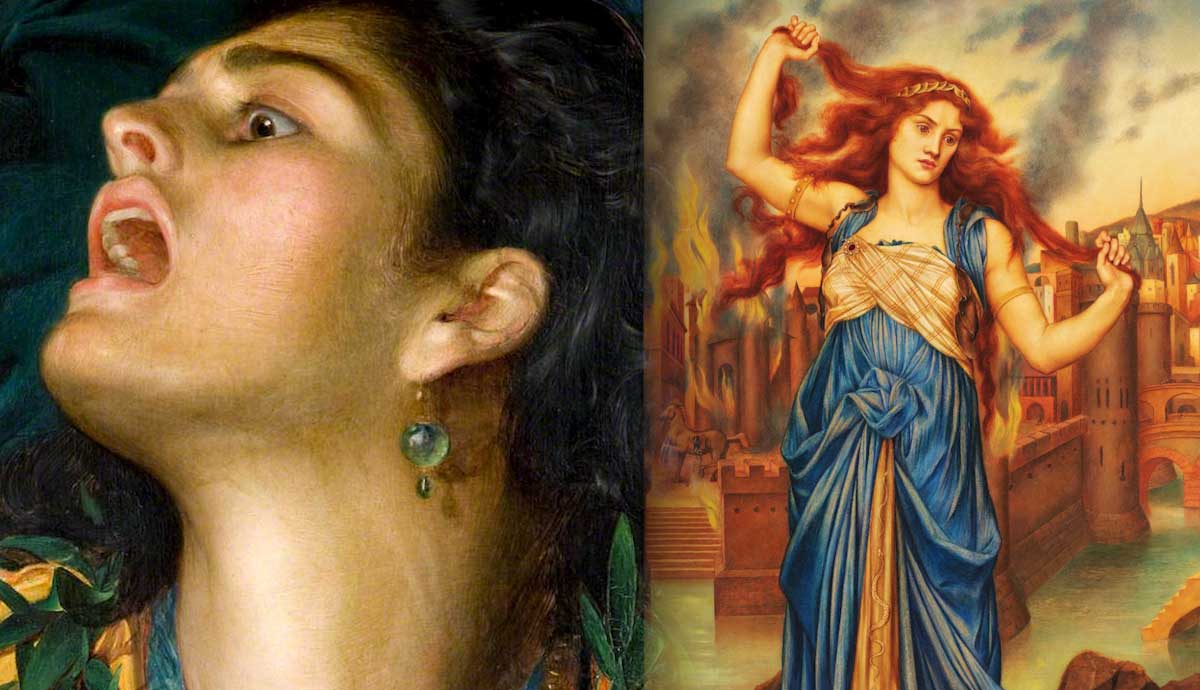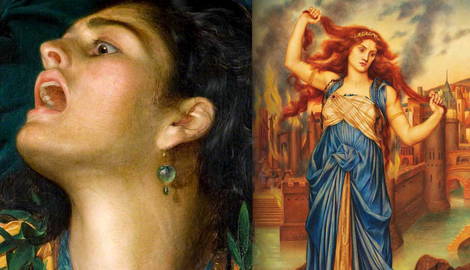
In Greek mythology, Cassandra was the daughter of King Priam and Queen Hecuba of Troy. Cassandra’s beauty and intelligence were renowned, and she was often sought after as a bride by many suitors. Indeed, the god Apollo fell in love with her and offered to grant her the gift of prophecy in exchange for her affection. Cassandra accepted the gift but refused Apollo’s love, so he cursed her so that no one would believe her prophecies, no matter how accurate they proved to be. That was just the beginning of her tragic story.
Cassandra of Troy: Etymology

The origin of “Cassandra” is not entirely clear, but one theory suggests that the name may have derived from the Greek word kassiteros, which means ‘shining upon men’. This theory aligns with Cassandra’s prophetic ability and the reverence with which she was held as a seer. Another theory suggests that the name may have originated from the Greek word kassandra, which means ‘helper of men’. The irony of this alternative origin is not lost, given Cassandra’s unfortunate fate. Despite her attempts to warn her fellow Trojans about their impending doom, her prophecies went unheeded, leading to the city’s destruction.
Mythology

As a priestess of Apollo, Cassandra was gifted with the extraordinary ability to foresee the future. Her prophetic visions were believed to be divinely inspired and highly revered among the people of Troy, often sought after by kings and nobles for her insights and advice. Her destiny took a tragic turn when, after spurning his advances, Apollo cursed her with a terrible fate: to speak true prophecies that no one would believe. Her warnings to the Trojans were ignored, and she was unable to prevent the fall of her city.
Cassandra’s character sheds light on the challenges faced by women in ancient Greek society. Throughout the Trojan War, Cassandra’s warnings about the fate of Troy are repeatedly dismissed by the Trojans, who view her as crazed and manic.

The defining characteristic of Cassandra is the pervasive disbelief in her prophecies, which renders her acutely aware of danger but powerless to prevent it. Cassandra’s sense of powerlessness is further amplified by her interactions with the other characters. Her warnings are ridiculed and dismissed, highlighting the challenges faced by those who are viewed as different or outside of the norm.
In certain versions of the myth, Cassandra’s tragic tale takes a further devastating turn. During the fall of Troy, Cassandra is assaulted by Ajax the Lesser inside the temple of Athena. Cassandra held onto the statue of Athena, seeking the goddess’ protection, but Ajax grabbed Cassandra away from the statue and raped her inside the temple, a clear act of sacrilege. Following Troy’s fall, the young priestess is captured by the Greek commander Agamemnon. As the daughter of King Priam, she was considered a valuable prize, but her prophetic powers made her a liability. Upon reaching Agamemnon’s homeland, Mycenae, Cassandra and Agamemnon are murdered by Clytemnestra, Agamemnon’s wife. Cletemnestra’s motive was revenge as she wanted to get back at Agamemnon for sacrificing her daughter, Iphigenia, right before the start of the Trojan War. In other accounts, Cassandra was killed by Ajax the Lesser who, angry because of her prophetic abilities, had taken her as his captive during the Trojan War.
The Aeschylean Captive

The story of Cassandra continues in the play Agamemnon by Aeschylus, where she is taken captive by the Greeks and brought to Agamemnon’s palace as a concubine. At the beginning of the play, Cassandra arrives at the palace and is greeted by a chorus of Elders who encourage her to enter. Despite their persuasion, Cassandra is hesitant and senses that something terrible is about to unfold. She then foretells that both herself and Agamemnon will die by the hand of his wife Clytemnestra.
As the play progresses, Cassandra’s predictions about the tragic destiny of Agamemnon’s family become increasingly dire. However, her warnings are dismissed, as Agamemnon believes himself to be invincible. Indeed, Cassandra senses the presence of Clytemnestra and warns Agamemnon not to trust her, but his hubris and arrogance blind him to the danger. Clytemnestra ultimately murders both Cassandra and Agamemnon in an act of revenge for the sacrifice of their daughter, Iphigenia; their wretched fate emphasizes the destructive power of human pride and the dire consequences of ignoring prophetic warnings.

As a captive concubine, Cassandra is viewed as a possession rather than a person, and her prophetic abilities are dismissed as madness, reflecting her limited agency. Although she lacks power, Cassandra refuses to be silenced and remains outspoken about the injustices she witnesses. Her actions demonstrate the importance of standing up for one’s beliefs, even in the face of overwhelming opposition. Her prophetic abilities and the curse of never being believed render her powerless to prevent the tragic events that unfold, but her defiance and resistance solidify her as a powerful character.
The Euripidean Slave

In Euripides’ Trojan Women, Cassandra is captured by the Greeks and brought to their camp, where she foretells the future destruction of the Greek heroes and their families. However, her prophecies are ignored, as she is treated as a slave and plaything by the Greek commander Agamemnon.
Cassandra’s character represents the heart-breaking reality of women in times of war, as she is subjected to sexual slavery and brutal treatment at the hands of her captors. Her prophetic abilities are also a central aspect of her character in this play. Like in the Iliad and Agamemnon, her prophecies are dismissed as madness, while her warnings about the tragic events that are about to unfold are ignored by those around her. Despite this, Cassandra’s character remains a symbol of resistance along with the other Trojan women, demonstrating their strength and bravery in the face of oppression.
The Virgilian Prophetess

Cassandra’s story is told in Book 2 of the Aeneid, when Aeneas recounts the fall of Troy to Queen Dido of Carthage. He describes how Cassandra warned her fellow Trojans about the dangers of the Greeks’ Trojan Horse. Despite her pleas and warnings, the Trojans ignore her, believing that the horse is a gift from the gods. Consequently, the Greeks emerge from the horse and slaughter the Trojans, leading to the fall of Troy. Cassandra’s prophecy is ultimately proven true, but her inability to convince the Trojans to act on her warnings serves as a tragic example of the limitations of prophecy in a world ruled by human emotions and irrationality. Book 4 of the Aeneid depicts Cassandra once again as a captive of the Greek king Agamemnon. Like Aeschylus’ narrative, Cassandra warns of the impending doom that will befall Agamemnon and his family, but her warnings are dismissed. Her role in Book 4 highlights the limits of prophetic knowledge and reaffirms her inability to alter the course of events that have already been set in motion.
In Book 6 of the Aeneid, Cassandra makes her final appearance as Aeneas encounters her in the underworld. Despite her tragic fate and the limitations of her prophetic abilities, Cassandra still speaks of the future and foretells the dangers Aeneas will encounter on his journey to establish Rome. Aeneas, however, chooses to listen to Cassandra’s warnings and takes measures to avoid the potential threats she has prophesied. This significant moment marks a departure from Cassandra’s previous interactions in the story, where her warnings were ignored or dismissed. By heeding her warnings, Aeneas is able to make informed decisions that ultimately lead to the establishment of Rome and the continuation of the Trojan legacy. Bittersweetly, Cassandra is allowed a final chance to aid the Trojan cause after being disregarded and mistreated since the beginning of the war.
The Homeric Princess

Cassandra does not have a significant role in the Iliad. She is only briefly mentioned in the text as a daughter of King Priam and Queen Hecuba of Troy, and as a priestess of Apollo. Cassandra’s only appearance is in Book 24, during the scene where Priam goes to Achilles’ tent to beg for the body of his son Hector. As Priam is leaving the tent with Hector’s body, he sees Cassandra and asks her to come with him. She refuses and states that she knows that she will die in Greece and that she wants to face her fate there. This brief moment highlights the idea that Cassandra has the ability to see the future, but her curse of not being believed makes her helpless to prevent it.
Cassandra of Troy & Her Afterlives

Cassandra of Troy has had a significant influence on art and culture, inspiring countless depictions in various forms of media. Her character’s tragic fate and prophetic abilities have captivated audiences for centuries, making her a popular subject in literature, art, and music. In literature, Cassandra has been featured in numerous works of fiction, including modern novels such as Margaret Atwood’s The Penelopiad and Christa Wolf’s Cassandra.
In art, Cassandra has been depicted in numerous paintings, sculptures, and other visual media. One of the most famous depictions of Cassandra is in a painting by Evelyn De Morgan, which shows her looking out at the destruction of Troy with a haunted expression on her face. The term “Cassandra complex” has been used to describe the phenomenon of someone predicting a future event but being ignored or dismissed; a term that has been applied to various situations, especially in the field of psychology to describe the difficulty of convincing others of the reality of a mental illness.









